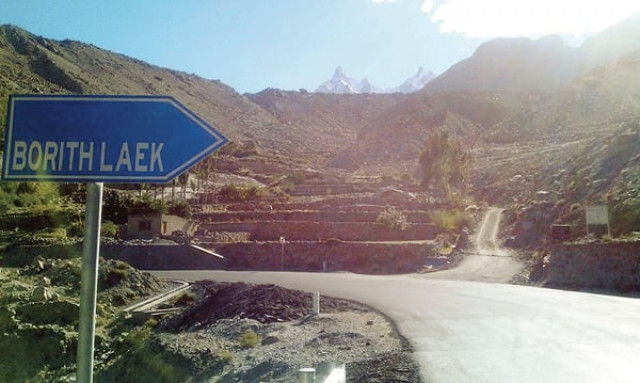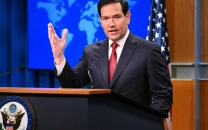Incorrect nameboards: No way to spell
Villages along KKH lose their identity to misspelt nameboards that paint over their history and cultural heritage.

Borith Lake.
Despite conducting the Environment Impact Assessment (EIA) — mandated by the Environmental Protection Agencies (EPAs) set up in Pakistan in 1993 as a consequence of the natural resource depletion after the highway’s construction in 1978 — the project has endangered the history and culture of the region.
The completion of the first phase of the project covering 335km from Raikote Bridge up to Khunjerab, although laudable, has left many villagers distraught with the National Highway Authority’s (NHA) delinquency. Mujeebur Rahman, an assistant professor at Karakoram International University (KIU), says, “The NHA has done a commendable job by expanding and upgrading the highway, however, its efforts are marred by sheer negligence in the naming of villages along the highway. It also shows its indifference to local culture and history.” And while the error may be limited to shuffling or omission of alphabets, its consequences extend far beyond faulty nameboards explains Rahman. “It confuses foreign tourists and visitors to the region (the Karakoram) who came here not only for its natural sceneries but also to learn about cultural diversity and the historical heritage of Gilgit-Baltistan.”

Jaffarabad village
Names of villages in Gilgit, for example, reflect human interaction and contact with the surrounding geography. They contain traces of the past and often provide anthropological cues to historians and anthropologists, which makes their correct documentation an absolute must. By turning Jutal into ‘Juata’, the village which derived its name for being a grassland is lost in translation. Similarly, turning Juglot into ‘Gaglot’, Khanabad, which originated when the king of Hunza, Nazeem Khan, declared the land free, into ‘Khanbad’, Thalichi into ‘Thalchi’, Parri Bangla, derived from the first development in the area, Dak Bangla, a place to stay, into ‘Parri Bhagla’ and Grall into an inventive ‘Garlet’, the authorities have twisted the meanings behind the names.

Juglot village
Borith Lake, to the northwest of Husseini, a village near Gulmit, in upper Hunza has been reduced to ‘Borith Laek’ on its nameboard and village names that take the suffix ‘abad’ have been completely deprived of it. For instance, Murtazabad is written as ‘Murtaza’, Sikandarabad as ‘Sikander’ and Jaffarabad as ‘Jaffar’. And these are still minor errors when compared with the entire renaming of the Baltit Fort in Hunza to ‘Hunzan Kingplace’.
In some instances, it has been speculated that the misspelt names have cropped up due to their Chinese pronunciation. Since 85% of the project was funded by China, their direct involvement in the project could have perhaps resulted in the naming anomalies. According to an NHA official, since the nameboards were spelled by the Chinese, the incorrect names were a result of their distinctive accent. He also assured that the boards will soon be taken down.
Along with misspelt names, authorities have overlooked many significant landmarks. “Despite the presence of numerous historical and other prominent sites, like the rock inscriptions of Haldikish, site of the Anglo-Hunza war, Bhoop Sing Padi, confluence point of three mighty mountain ranges etc, the company has completely ignored these,” says Rahat Karim Baig, assistant director tourism. According to him, such mistakes can be avoided in the future by involving the tourism department.
“Such blunders can be avoided by involving local communities in the overall project plan and consulting tehsil officials and documents in the local administration,” says Wajahat Ali, a conservation architect. “But it seems that the company working on the KKH has relied more on guides for naming. As a result, we see the highway peppered with incorrect names.” When KKH was completed in the ’70s, the area was cut off from modern means of communication and deprived of advanced technologies. To work around this, authorities had hired individuals with good handwriting to complete the task of chiseling town names on milestones that were later painted over in black. The task was completed with visibly fewer mistakes, if any.

Baltit Fort
Currently as the boards stand in their upgraded form, the odds of finding one with the correct spelling are close to impossible. For some villages, they seem to be missing completely. And while the blatant errors are noticed by commuters along the highway, they have managed to slip past the watchful eyes of the authorities.
Aziz Ali Dad is a social scientist from Gilgit.
He can be contacted at azizalidad@gmail.com
Published in The Express Tribune, Sunday Magazine, March 30th, 2014.



















COMMENTS
Comments are moderated and generally will be posted if they are on-topic and not abusive.
For more information, please see our Comments FAQ